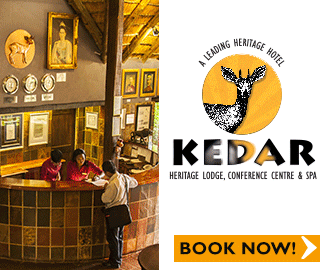
Planning a trip to Namibia
BY KRISTIE OMAR 16 OCT, 2016 16:30
Planning a trip to Namibia? Wondering where to go, when and how to get there and all the things to do? Travelling through Namibia by car is one of the best ways to explore the extremely vast and beautiful country. This, plus the freedom you have to stop and go as you please, makes self-driving in Namibia extremely rewarding.
Here you’ll find some important tips to make the most of your road trip in Namibia and discover the natural wonders of the country.
Things you should have in your car:
A camera: This is something that is invaluable on your trip through Namibia. From wild animals to stirring landscapes and interesting people, there are photo opportunities galore and documenting your road trip is a great way to make the memories of your adventure last even longer.
Water: Always bring loads of bottled water in the car with you. Namibia can be very hot and you may drive for an hour without seeing any settlement, so always make sure you’re hydrated.
Snacks: As always when driving, make sure you have a little bit of food to nibble on to keep up your spirits and sugar levels. If you don’t eat properly your alertness could suffer and that’s not ideal.
Sunglasses and sunscreen: Protect yourself from the sun while driving. Many people forget that they can get sun burnt whilst in a car. Wearing a good pair of sunglasses will not only protect your eyes, but also reduce the sun’s glare, which will help you be able to spot animals and other things in the distance.
Fill up on petrol when you have the chance: There are many fueling stations dotted along the national roads, but you must always make sure that you have enough petrol or diesel in your car to get from one station to the next. Namibia is a sparsely populated country and getting stuck with no fuel is not an ideal situation. Some maps will tell you where the filling stations are, but don’t simply trust any old map you find online as it could be out of date.
**Note! Many filling stations do not accept card payments for fuel, so always have enough cash to pay for your fuel. It should also be noted that not every filling station has an ATM, so be sure to have enough cash on you before you start your self-drive adventure.**
Know the major national roads
The national roads of Namibia are all labelled with the letter ‘B’ and you can use them to get to most major destinations in the country.
Only take secondary roads if your car can handle it
The secondary roads are identified by either their ‘D’ or ‘C’ prefixes and these roads are mostly un-tarred, graded dirt roads. These roads are more often than not easy to drive on, but do bear in mind that you will need a car that can handle a little bit of sand and dust when using some of them.
When you begin exploring the country’s secondary road network in earnest, you will find loads of little gems hidden along the way. Quiet rest camps, conservation centres, traditional communities and even the largest meteorite in the world!
Look out for animals!
No matter what road you’re driving on, highways or side roads, you need to be on the lookout for animals. Not only because they are amazing to spot and observe, but because they can run into the road rather unexpectedly.
Warthogs can be particularly dangerous as they are relatively difficult to spot from a distance, and will cause some serious damage to your vehicle if hit at high speed. Kudus (and other antelope) have also been known to panic and run in front of cars, so be aware, especially if you see road signs warning of the likeliness of one of these animals.
The animals are most active during dusk and dawn, so if the sun’s going down, or if the sun’s coming up, then sharpen your wits and keep a close eye on the verge of the road.

Namibia is a land of endless blue skies, vast horizons and crisp mornings: pure joy for photography enthusiasts. It is also safe, clean and organised with an excellent infrastructure, making it a favourite destination for family vacations.

Make sure your car is ready for adventure
Whether you are driving your own vehicle or have chosen to rent one, you will need to pick the appropriate type of car for your journey. If you are planning to stay on the national roads and not go gallivanting into the untamed wilderness of Namibia, then any reliable mass-produced four door sedan should do you just fine. Do bear in mind though that a car with a very low ground clearance may run into trouble, so it’s probably best to leave the sports-sedan at home.
Kick it old school – bring your map along
GPS is a wonderful invention and it has made navigating around unexplored parts of the world a cinch for travel, and it is highly recommended that you invest in such a device if you plan on driving yourself around the countryside.
However, it is still VERY important that you bring a physical map with you. Electrical equipment can fail, so you need to have a backup plan. A map is solid and dependable and it never has to reacquire its satellites.
Prepare to take a few dirt roads
Many of the roads in Namibia are not tarred and as such, you will find yourself driving on either dirt or gravelled roads at some point. But do not fear. Most of these roads are well graded and easy enough to drive on.
A few more nuggets...
It’s a good idea to leave your headlights on through the day and night. Headlights, even in daylight, make your car easier to see for oncoming vehicles.
Drive carefully and cautiously, as always. Be especially careful when leaving or entering villages and towns. There are often people and cattle crossing the road.
Make sure you have a roadside emergency kit in your car. If you have rented a vehicle make sure with the agency that there is a kit in your vehicle. You should always travel with a basic first-aid kit.
Do not speed! The penalties for exceeding the local speed limits are extremely severe, and law enforcement is wide-spread.
Cellphone reception is not consistent all over the country, so have a look at your service provider’s coverage map to see if where you’re going will have service.
Always ensure you have more than enough fuel to get to your destination or the next filling station.
Drive on the left, even on deserted dirt roads. If you pass through any farm gates you have to open, be sure to close them behind you. If you don’t then livestock will escape and you will be costing a farmer a lot of damage.















